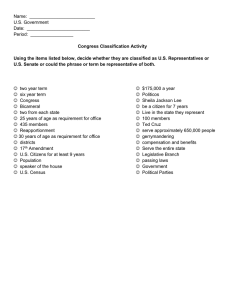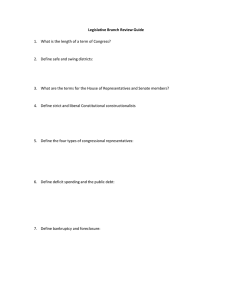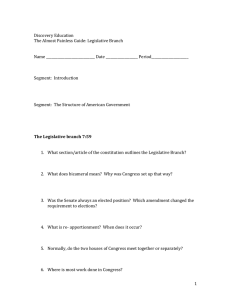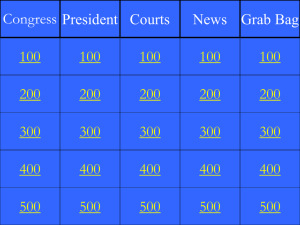Goal 2 Part 2 Study Guide
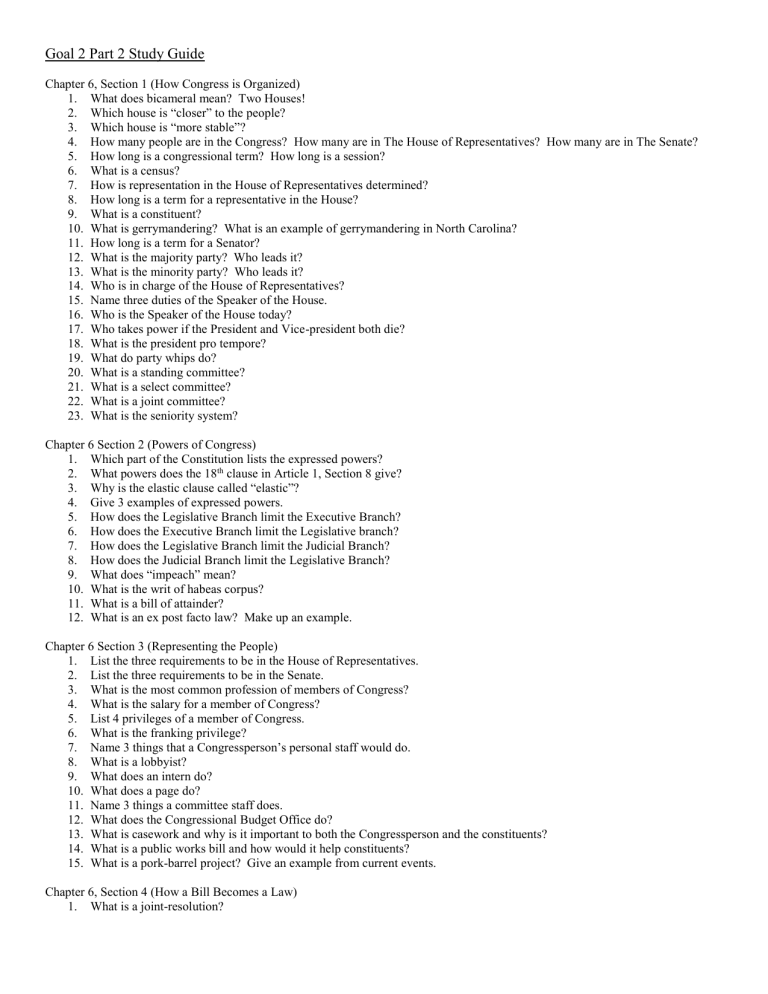
Goal 2 Part 2 Study Guide
Chapter 6, Section 1 (How Congress is Organized)
1.
What does bicameral mean? Two Houses!
2.
Which house is “closer” to the people?
3.
Which house is “more stable”?
4.
How many people are in the Congress? How many are in The House of Representatives? How many are in The Senate?
5.
How long is a congressional term? How long is a session?
6.
What is a census?
7.
How is representation in the House of Representatives determined?
8.
How long is a term for a representative in the House?
9.
What is a constituent?
10.
What is gerrymandering? What is an example of gerrymandering in North Carolina?
11.
How long is a term for a Senator?
12.
What is the majority party? Who leads it?
13.
What is the minority party? Who leads it?
14.
Who is in charge of the House of Representatives?
15.
Name three duties of the Speaker of the House.
16.
Who is the Speaker of the House today?
17.
Who takes power if the President and Vice-president both die?
18.
What is the president pro tempore?
19.
What do party whips do?
20.
What is a standing committee?
21.
What is a select committee?
22.
What is a joint committee?
23.
What is the seniority system?
Chapter 6 Section 2 (Powers of Congress)
1.
Which part of the Constitution lists the expressed powers?
2.
What powers does the 18 th clause in Article 1, Section 8 give?
3.
Why is the elastic clause called “elastic”?
4.
Give 3 examples of expressed powers.
5.
How does the Legislative Branch limit the Executive Branch?
6.
How does the Executive Branch limit the Legislative branch?
7.
How does the Legislative Branch limit the Judicial Branch?
8.
How does the Judicial Branch limit the Legislative Branch?
9.
What does “impeach” mean?
10.
What is the writ of habeas corpus?
11.
What is a bill of attainder?
12.
What is an ex post facto law? Make up an example.
Chapter 6 Section 3 (Representing the People)
1.
List the three requirements to be in the House of Representatives.
2.
List the three requirements to be in the Senate.
3.
What is the most common profession of members of Congress?
4.
What is the salary for a member of Congress?
5.
List 4 privileges of a member of Congress.
6.
What is the franking privilege?
7.
Name 3 things that a Congressperson’s personal staff would do.
8.
What is a lobbyist?
9.
What does an intern do?
10.
What does a page do?
11.
Name 3 things a committee staff does.
12.
What does the Congressional Budget Office do?
13.
What is casework and why is it important to both the Congressperson and the constituents?
14.
What is a public works bill and how would it help constituents?
15.
What is a pork-barrel project? Give an example from current events.
Chapter 6, Section 4 (How a Bill Becomes a Law)
1.
What is a joint-resolution?
2.
What are the five steps a bill must go through to become a law? a. b. c. d. e.
3.
What is a special interest group?
4.
Who can introduce a bill?
5.
What are the five things a committee can do with a proposed bill? a.
b.
c.
d.
e.
6.
How is the ability to add amendments to a bill different between the House and the Senate?
7.
How is debate different between the House and the Senate?
8.
What is a filibuster?
9.
How can a filibuster be stopped?
10.
What are the three main types of votes?
11.
What are the three things the president can do with a bill? a.
b.
c.
12.
If the president pocket vetoes a bill, and Congress is in session, what happens? What if Congress is not in session?
13.
How can Congress override a veto?
